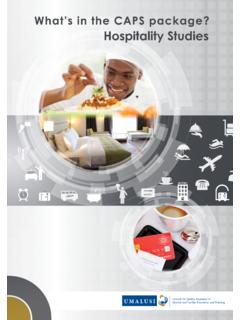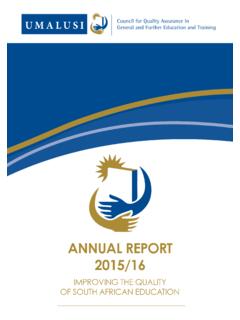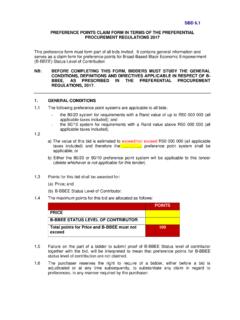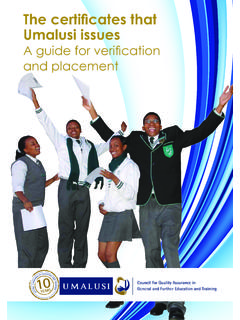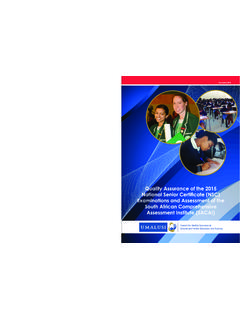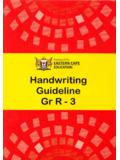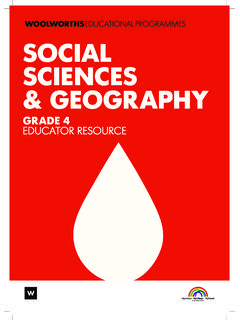Transcription of What’s in the CAPS package? - Umalusi
1 What s in the caps package? A comparative study of theNational curriculum Statement (NCS) and theCurriculum and assessment policy Statement ( caps )Further Education and Training (FET) PhaseMathematics Dr L Bowie Dr Z Davis Prof P Pillay Mr HB Nxumalo Ms LC Pleass Ms MG RajuWith Dr S Grussendorff Dr C BooyseJune 2014 COPYRIGHT 2014 Umalusi , COUNCIL FOR QUALITY ASSURANCE IN GENERAL AND FURTHER EDUCATION AND TRAINING: ALL RIGHTS RESERVED37 General Van Ryneveld Street, Persequor Technopark, PretoriaTelephone.
2 27 12 3491510 Fax: 27 12 3491511 Email: Web: all reasonable steps are taken to ensure the accuracy and integrity of the information contained herein, Umalusi accepts no liability or responsibility whatsoever if the information is, for whatsoever reason, incorrect and Umalusi reserves its right to amend any incorrect 2014 ACKNOWLEDGEMENTSThis Mathematics report includes the findings emanating from the comparative analysis of the Further Education and Training (FET) National curriculum Statement (NCS) and the curriculum and assessment policy Statement ( caps ) for Mathematics as well as a sum-mary of findings from Part 2 of the caps research. Part 2 of the research determined entry level requirements and expected learner attainment on exit level. A summary of the exit level outcomes for these subjects also appears in the Overview project was envisaged and conceptualised by Dr Celia Booyse, Manager: Curricu-lum, Umalusi .
3 The project was co-managed by Dr Booyse and Dr Sharon Grussendorff, who provided much of the constructive commentary on the original subject reports and prepared all the spreadsheets for the transfer of data. Dr Grussendorff also helped to adapt the research instruments for the comparative analysis of the NCS and the caps , used in determining entry-requirements and exit-level outcomes, as well as the instrument used for international benchmarking (reports to follow).Dr Grussendorff, a respected researcher, Physics lecturer and consultant to many educa-tional initiatives, has been involved with Umalusi s curriculum research since 2006. In 2012, she was approached by Umalusi s Qualifications, curriculum and Certification (QCC) unit to co-manage the caps quality assurance research. In addition to her management role, Dr Grussendorff has also been team leader for the Physical Sciences team in the FET Phase.
4 Her experience in teacher-support and training in curriculum interpretation with JET Education Services have contributed invaluably to the present research as Booyse has managed the caps evaluation with her usual immaculate planning, thor-ough preparation and gentle humanity. The evaluation teams will attest to the fact that they are properly briefed and given the means to do their work well. Dr Booyse almost intuitively, it seems, manages that fine balance that Jerome Bruner writes about between a safe, loving environment and sufficient challenge that allows for the best Booyse has been steadily supported by her colleagues in the QCC unit: Ms Elizabeth Burroughs, Senior Manager: QCC; Mr Duma Sithebe, Assistant Manager: curriculum ; Mr Mohau Kekana, Administrative Assistant; and Mr Mohlahledi Nkadimeng, Administrative Assistant. Mr Sithebe ably assisted in constituting the evaluation teams, dealing with communi-cation and undertaking the greater part of the document search for the comparative research, each of these a considerable teams undertaking these evaluations have far exceeded the call of duty, and for that we at Umalusi thank them.
5 Their unstinting hard work and willingness to be stretched by challenges requires grateful recognition. The positive attitude within the teams and the in-depth discussions and collaboration are commendable. It has been satisfying to see that we have all learned from one another s expertise and that all who have par-ticipated in the process go out with an enriched understanding of the importance of curriculum and its appropriate implementation. It is to be hoped that the accumulat-04 Umalusi 2014ed knowledge and wisdom emanating from the project will have positive repercussions in schools, provincial departments, the national Department of Basic Education and in higher education is worth referring to Annexure A in the Overview report to fully appreciate the wealth of experience and commitment this project has been privileged to draw upon. The team who contributed to this Mathematics report is:Dr Lynn Bowie - Team leader for the Mathematics team and Mathematics Education coordinator for OlicoDr Zain Davis - Senior Lecturer, Mathematics Education: University of Cape Town (UCT)Mr Hector B Nxumalo - Deputy Chief Education Specialist, KZNMrs Mariamma G Raju - Senior Education Specialist, Eastern CapeMs Leigh C Pleass - Master teacher of Mathematics for the South African Board of Jewish Education (SABJE)Prof Poobhalan Pillay Professor, Mathematics and external moderator for UmalusiThis report was edited by Dr Claire Kerry.
6 Her work requires grateful recognition. IeCommunications was responsible for the final design, layout and printing of the report. Their willingness to help when deadlines were tight is gratefully the sustained work of the Umalusi teams and the detailed, extensive reports writ-ten by the people duly acknowledged above, the Overview report and this Mathemat-ics report could not have been written. Sincere appreciation for every contribution made to the research and to make the reporting on findings possible. 05 Umalusi 2014 CONTENTSA cronyms and Overview: A Comparative Analysis of the NCS and caps for the FET The research question, research methodology and Trends across the The nature of the curriculum curriculum Breadth and depth of Specification of Sequencing and assessment curriculum curriculum Implications for the South African Concluding Mathematics: A Comparison of NCS and caps for the FET List of documents Broad curriculum design, format and user-friendliness of curriculum curriculum Content coverage: breadth and Coverage (Breadth).
7 Specification of Comments on content / skill curriculum weighting and curriculum emphasis within the phase (subject time allocation).. curriculum emphasis within the subject (topic weighting).. curriculum curriculum sequencing and Specification of Indication of Specification of pedagogic assessment curriculum Integration between Integration with the everyday world and knowledge of curriculum curriculum Implications for South African Assumptions regarding teacher Concluding Mathematics: Exit-level outcomes for the FET Phase A: 2014 ASAssessment StandardsCAPSC urriculum and assessment policy StatementDBED epartment of Basic Education and TrainingDocDocumentDoEDepartment of EducationFALF irst Additional LanguageFETF urther Education and TrainingGETG eneral Education and TrainingGrGradeHESAH igher Education South AfricaHLHome LanguageICTI nformation and Communications TechnologyITInformation TechnologyLOLearning Not datedNCSN ational curriculum StatementNSCN ational Senior CertificateOBEO utcomes-based Educationp pagepppagesSBAS chool-based AssessmentQCQuality CouncilQCCQ ualifications, curriculum and CertificationACRONyMS AND AbbREvIATIONS08 Umalusi 20141.
8 OvERvIEW: A COMPARATIvE ANALySIS OF THE NCS AND caps FOR THE FET bACKGROUNDU malusi undertook a project in 2013, the core intention of which was to establish the quality of the curriculum and assessment policy Statement ( caps ) as amended version to the National curriculum Statement (NCS) of 2008. The work done in 2013 is not only an extension of research to further the understanding of the National Senior Certificate (NSC) qualification, but is similar to the comparative research done in 2008. The research such as this not only develops an understanding of the strengths and weaknesses of the subject curricula, but also assists in building bigger picture of the nature of the qualifica-tion itself what its strengths might be and what challenges might arise for the institutions where it is offered and for the staff implementing it. In short, the research was undertaken with the purpose of ensuring a better understanding of the NSC for all current phase of the research is presented in the following reports: An overview report of the research process and key findings for subjects and sub-ject clusters A series of subject/subject cluster- specific reports for Mathematics, Mathemati-cal Literacy, Languages (English), Social Sciences, Natural Sciences and Business, Commerce and the reports will be submitted to the Department of Basic Education and Training (DBE).
9 The findings and recommendations have been formulated as guidelines for im-provement, in terms of both the national policy and of implementation and assessment . The findings also point to areas that need strengthening in teacher education and profes-sional development. Thereafter, Umalusi , in collaboration with Higher Education Institutions and Higher Education South Africa (HESA), could use this research work towards improving the quality of teacher preparation, not only to equip teachers as field experts, but also as subject methodologists who are able to reflect on their own teaching practice. THE RESEARCH QUESTION, RESEARCH METHODOLOGy AND INSTRUMENT Research question: The research question for the comparative NCS/ caps research/ evaluation is worded as follows: What does the comparison between the curriculum and assessment policy Statement ( caps ) for FET Phase (Grades 10 to 12) and the National curriculum Statement (NCS) reveal about:a.
10 The extent to which the NCS curricula were repackaged or rewritten in the formula-tion of the caps ;b. the relative depth and breadth of the content covered in the respective curricula,c. the overall design, structure and coherence of the curricula,09 Umalusi 2014d. the level of specification of various aspects of the curricula, ande. the guidance provided by the curricula for the teaching and assessment of the subject? Research/evaluation process: The process involved identification of the evaluation teams across all the subjects under evaluation, followed by the refining of an existing instrument to evaluate and compare the NCS and the caps . Thereafter two workshops were held with the evaluation teams, in August and November of 2013, in order to brief them about the evaluation and for the teams to work together on the curriculum analysis. Finally, the evaluation teams completed their analysis via e-communication, and the team leaders took responsibility for the completion and submission of the teams reports.




